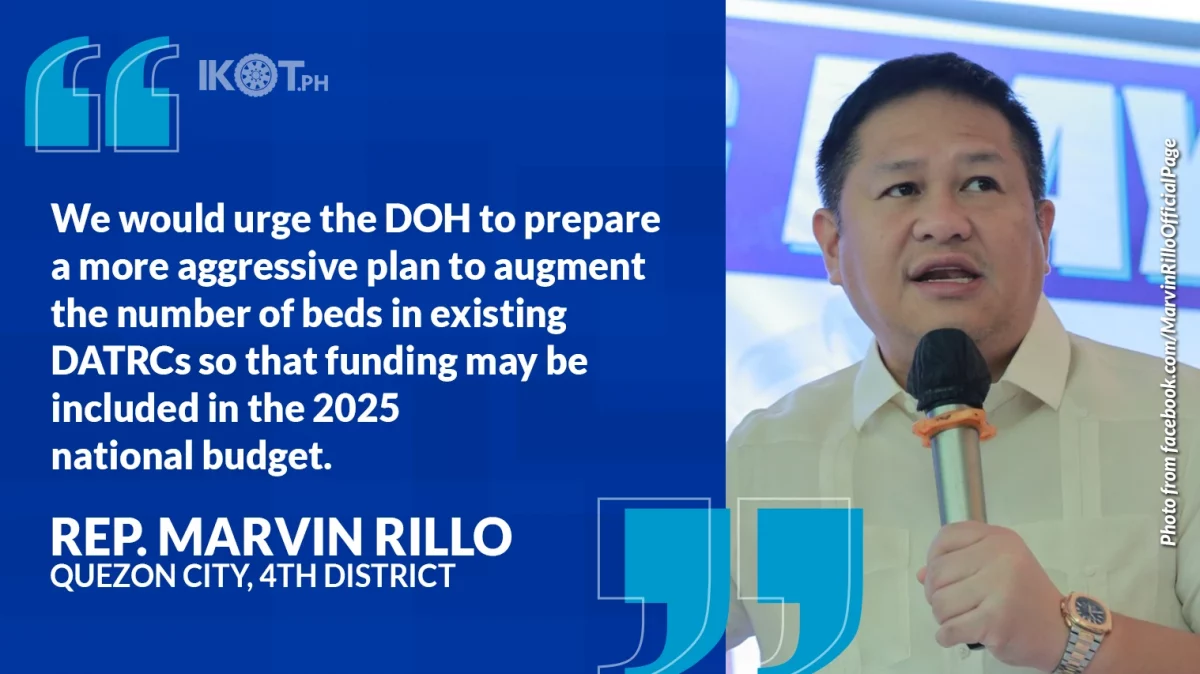Quezon City Representative Marvin Rillo wants the Department of Health (DOH) to submit to Congress a comprehensive plan to upgrade the bed capacities of public residential drug abuse treatment and rehabilitation centers (DATRCs), amid reports that a number of them are often getting overcrowded and have to put on a waitlist individuals seeking admission.
“We would urge the DOH to prepare a more aggressive plan to augment the number of beds in existing DATRCs so that funding may be included in the 2025 national budget,” Rillo, a member of the House committee on appropriations, said.
“If we want to succeed in suppressing the demand side of our illegal drug problem, we have to improve public access to DATRC services.”
“If we want to succeed in suppressing the demand side of our illegal drug problem, we have to improve public access to DATRC services,” the legislator said.
Under the law, a drug dependent may, by himself/herself, or through his/her parent, spouse, guardian or relative within the fourth degree of consanguinity or affinity, voluntarily seek admission to a DOH-run DATRC.
Any person arrested, and who is found positive for illegal drug use after a confirmatory test, also faces compulsory six months minimum rehabilitation in a DOH-run DATRC.
The DOH currently operates 23 DATRCs in 14 regions.
In the 2024 General Appropriations Law, the DOH is spending P1.58 billion to operate the DATRCs, which are also getting an additional P409 million in combined capital outlay to upgrade and expand their facilities, according to the lawmaker.
“We are ready to endorse bigger funding in 2025 to increase the beds of existing DATRCs, and to build new centers if necessary in regions where there is growing demand for their services.”
“We are ready to endorse bigger funding in 2025 to increase the beds of existing DATRCs, and to build new centers if necessary in regions where there is growing demand for their services,” he said.
In Luzon, the DOH runs the Bicutan Rehabilitation Center; Las Piñas Drug Abuse Treatment and Rehabilitation Center; Dagupan Rehabilitation Center; San Fernando, La Union Treatment and Rehabilitation Center; Bauko, Mountain Province Treatment and Rehabilitation Center; Isabela Rehabilitation Center;
Bataan Rehabilitation Center; Mega Drug Abuse Treatment and Rehabilitation Center; Drug Abuse Treatment and Rehabilitation Center CALABARZON; Tagaytay Rehabilitation Center; Camarines Sur Rehabilitation Center; and Malinao, Albay Rehabilitation Center;
In the Visayas, the DOH operates the Pototan, Iloilo Rehabilitation Center; Argao, Cebu Rehabilitation Center; Cebu City Rehabilitation Center; and Dulag, Leyte Rehabilitation Center;
In Mindanao, the DOH runs the Zamboanga City Treatment and Rehabilitation Center; Cagayan de Oro Rehabilitation Center; Malaybalay, Bukidnon Treatment and Rehabilitation Center;
Malagos, Davao Treatment and Rehabilitation Center; SOCCSKSARGEN Drug Abuse Treatment and Rehabilitation Center; CARAGA Rehabilitation Center; and San Francisco, Agusan del Sur Treatment and Rehabilitation Center.


